FAQ
- Bolivia climbing questions
-
Mallorca island and rockclimbing
- What are main specifics of rockclimbing trip to Mallorca
- Mallorca island impressions
- Rockclimbing safety Spain
- Mallorca climbing accommodation
- What season is possible for rockclimbing in Mallorca
- Transport accessibility of climbing sectors in Mallorca
- Active vacation in Mallorca
- Saint Anthony night in Mallorca
- Peru climbing questions
- Gear reviews
- Safety in the mountains
- Health in the mountains
-
Elbrus questions
- Elbrus climbing gear
- Climbing Elbrus with children?
- Mount Elbrus location?
- Elbrus logistics
- How to get to Mount Elbrus?
- Elbrus German airfield?
- Elbrus difficulty grade
- What difficulties climbers will face in the process of climbing Mount Elbrus?
- How to prepare for Elbrus?
- Are there avalanches on Mount Elbrus?
- Is it possible to climb alone the highest mountain of the Caucasus and Europe - Elbrus?
- At what time of the year is it better to climb Elbrus?
- How long does climbing Elbrus last?
- Clothes for Mount Elbrus?
- Pressure at the top of Elbrus?
- Elbrus air temperature
- Elbrus sightseeing
- How much to climb Elbrus
- Gear questions
- Mountaineering questions
- Mountain climbing training
- Rockclimbing questions
- Horse riding tours
- Iceclimbing questions
-
Questions on the alpine programs
- Georgia 2023
- Pico Aneto - what is that mountain?
- Mountain climbing food ration
- Queries on the alpine program climbing Mount Bazarduzu
- Queries on the Kamchatka alpine program climbing
- What is combined program?
- What is Sightseeing program?
- What is pilot program?
- What programs you have of the medium complexity level?
- Basic expedition rations
- Prices for the mountain climbing programs
- Queries on the Mountain Course in Adyl Su valley
- Program complexity?
- Questions about MCS AlexClimb
- Questions related to trekking programs
Elbrus climbing gear
Read in Telegram in English
Leer en Telegram en Español
My collection of routes to Elbrus is here
Selection of climbing equipment for climbing Mount Elbrus - depending on the route
In this article, I would like to invite you to read some of my recommendations for using special technical climbing and camping equipment for Mount Elbrus expeditions. The material presented below is based on my more than 20 years experience of climbing Mount Elbrus. This text does not concern issues of clothing and footwear - these issues are discussed in another article.
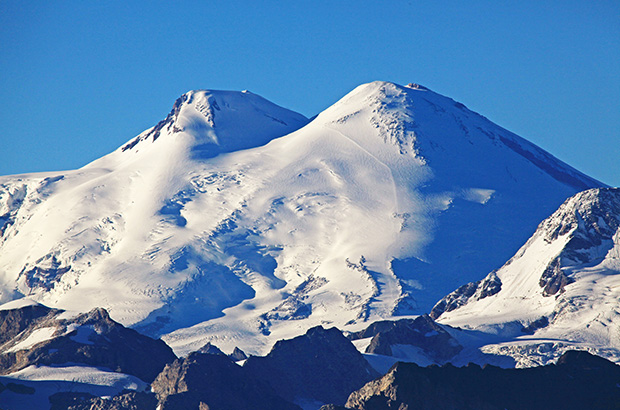
Elbrus - southern slope. The trail to the saddle up from the Pastukhov rocks is clearly visible
Let me start with the fact that all the classic routes for climbing Mount Elbrus - from the south, north, east and west - are these routes are of low (initial) climbing category of difficulty, which do not present serious technical obstacles.
The main difficulty of climbing Mount Elbrus lies in its serious altitude, difficult weather conditions and the length of the routes, which require good physical preparation and acclimatization.
Climbing Mount Elbrus along the southern slope
Also, regardless of the route, an important condition for your safety and success in Mount Elbrus climb is the correctly chosen climbing tactics. Climbing tactics include a properly selected set of equipment - your mobility on the route and the level of physical load directly depend on the weight and volume of your gear.
Optimizing your equipment and eliminating all unimportant or unnecessary elements allows you to reduce the weight of your backpack - this is very important in order to maintain your energy and performance at the critical altitudes.
Crossing roped the Dzhainkau-Ginkyoz glacier - climbing Mount Elbrus along the east route
The set of alpine equipment for climbing Mount Elbrus depends on the chosen route and the tactical plan for the ascent. For example, if you plan to climb Mount Elbrus during the summer season along the most popular route from the south. If you plan to use all the infrastructure available - cable car, hotels, snowcat for getting to level 4800 - then you will need a minimum set of equipment. Most likely only light climbing crampons and telescopic trekking poles will be enough.
The southern slope is the most popular climbing route to Mount Elbrus
On the other hand, if you choose the most difficult of the classic Mount Elbrus routes - from the west, then you will need the entire set of technical alpine equipment to organize belay on the steep sections and the entire set of camping gear for an autonomous expedition - tents, sleeping bags, mats, cooking equipment.
Climbing Mount Elbrus along the route from the West
As a rule, in order to prepare well for Elbrus climb, you need to have an accurate understanding of all the obstacles that you will encounter on the route. The more accurately you understand the task, the easier it will be to draw up a tactical plan and select the necessary set of equipment, eliminating all unnecessary items. To do this, it is recommended to read carefully all the available route descriptions and find information about recent climbs and its current condition.
At sunset in the camp 2900 on the Mount Elbrus Western route
I bring to your attention a brief description of the technical features of all main Mount Elbrus routes and according specifics of using of the special equipment for each of them:
Base camp 4050 on the Southern route to Elbrus
Features: Availability of refuges and transportation (snowcats, snowmobiles) up to a level of 4800 m, in normal weather conditions - a continuous marked trail to the summit. There is a possibility of a small icy section (of the length of 30-40 m) at an altitude of 5400 m - the fixed rope can be found there.
Hazards: adverse weather conditions, difficulties with route finding in case of bad weather
Required climbing equipment: sleeping bag, light mountaineering crampons, trekking poles
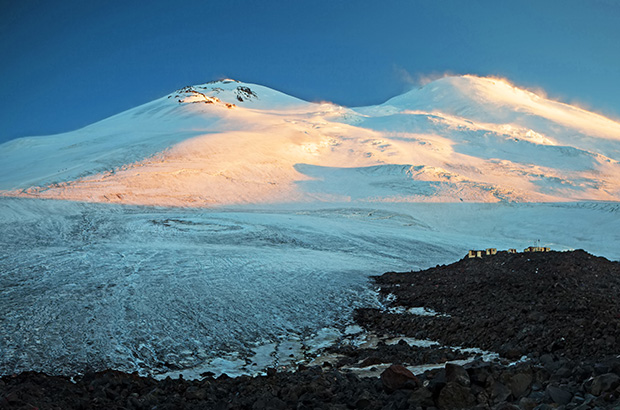
The northern slope of Mount Elbrus is the second in the popularity and difficulty Mount Elbrus route
Features: Small (compared to the southern route) number of refuges, lack of transportation options. Under normal conditions there is a continuous marked trail to the summit. The upper part of the route to the West summit of Mount Elbrus coincides with the South route.
Hazards: adverse weather conditions, difficulties with route finding
Necessary climbing gear: tent, sleeping bag, mat, light mountaineering crampons, trekking poles
At camp 3900 after climbing the Mount Elbrus East route
Features: no refuges nor marked trail, route duration 3-4 days
Hazards: unfavorable weather conditions, difficulties with route finding, crevasse danger when crossing the Jinkau-Ginköz plateau, possible icy pitch before reaching the summit dome.
Necessary climbing equipment: tent, sleeping bag, mat, light mountaineering crampons, trekking poles, ice axe, rope, harness, ice screws and carabiners. Emergency kit for crevasse rescue + practiced skill of using it
Climbing Mount Elbrus along the West route (via Utyug)
Features: no refuges nor marked trail, duration of the route is 5-6 days, rather steep ice section at an altitude of 4400 m (screw belay is required for climbing)
Hazards: adverse weather conditions, difficulties with route finding, crevasse danger on the glacier plateau above Utyug Rock, possibility of rockfall, risk of falling on a steep ice section
Necessary climbing equipment: tent, sleeping bag, mat, light mountaineering crampons, trekking poles, helmet, ice axe, rope, harness, carabiners, ice screws
In accordance with the above brief overview of the Elbrus climbing routes, the dependence of the equipment set on the technical features of the route is visible.
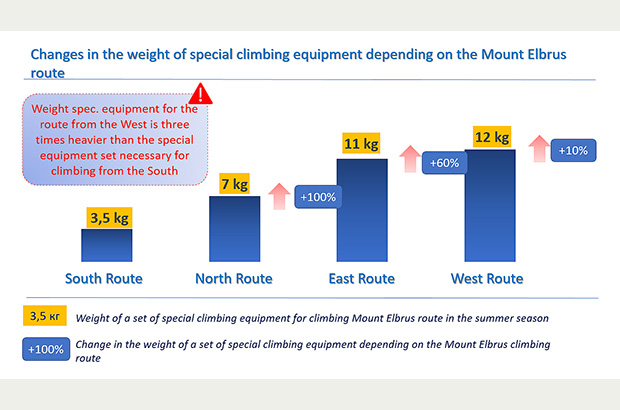
Dependence of the weight of a set of equipment for climbing Mount Elbrus on the choice of the route
I am often asked why many companies that organize commercial climbs of Mount Elbrus along the easiest route from the south, load their clients with all the possible climbing equipment - harnesses, helmets, ice axes, etc.?
The answer is obvious - that it looks cooler and sells more expensive. As a rule, the audience of such programs is not expected to have mountaineering experience. An ordinary participant (client) of Mount Elbrus climb cannot independently figure out whether he needs this equipment or not.
So what is given should be taken.
The second reason for this may well be the insufficient experience and lack of qualification of the organizers and guides of such ascents. Many people think that the principle works in the mountains - more equipment - safer climb. Even if no one knows how to use that equipment.
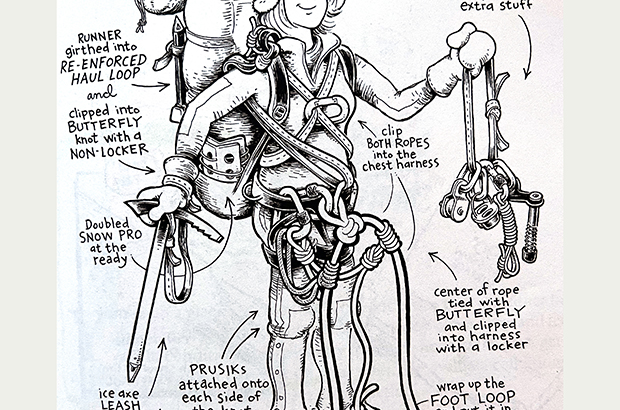
The principle of 'more is better' - does not work regarding the amount of equipment on the mountaineering routes
If on the Mount Elbrus routes from the east and west there is indeed a possibility of encountering technical climbing obstacles, which require special climbing equipment to overcome, then two other routes - South and North are accessible for climbing with a minimum set of equipment.
At the summit of Mount Elbrus, climbing along the western route
Using the example of the South and North Mount Elbrus routes, I propose to understand the feasibility of using individual parts of climbing equipment.
It is important to understand that these recommendations apply only to the Mount Elbrus ascents that are organized during the summer season under the leadership of a professional guide. These recommendations are not supposed for preparing an independent or unsupported expedition.
Ø Let's start with the rope and harness. By getting roped on a difficult climbing route, climbers protect themselves against falls on a steep section or falling into a crevasse. (I have a separate text regarding illusions of safety when using a rope)
.jpg)
Passing roped a route by crevassed closed glacier - on the Eastern route to Mount Elbrus
1. The first danger - a fall - is unlikely while climbing Mount Elbrus under standard conditions due to the low steepness of the slopes. In the summer, if there is snow cover, it is almost impossible to fall or slide down climbing Mount Elbrus.
2. The second danger, more typical for Mount Elbrus, is numerous crevasses. The slopes of this mountain - that is a body of a mighty glacier, covered with snow and containing numerous crevasses of varying widths and depths, often masked by snow and therefore very dangerous.
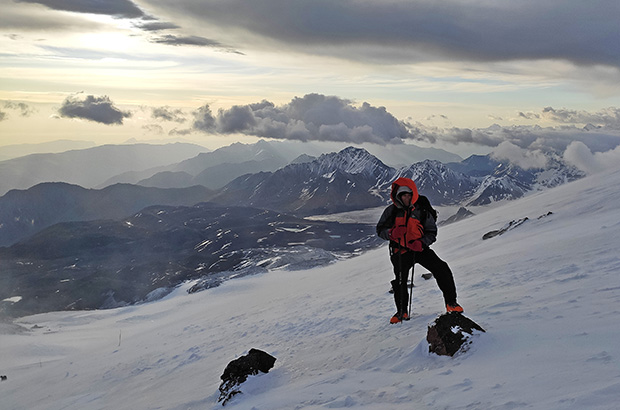
Climbing Mount Elbrus along the north slope
However, the possibility of falling into a crevasse arises only if you deviate from the line of the marked trail (which is a clear prerequisite for a serious accident).
In this case, a rope most unlikely will help you (read this), since its use requires professional crevasse rescue skills.
The main safety requirement for climbing Mount Elbrus is that you should never leave the safe trail. As long as you are on the trail, there is no point to use a rope. At an altitude of 5400 meters, slightly above the Saddle close to the approach to the Western Summit, there is a short section that requires caution when passing or some basic belay.
A section of the slope of the Western Summit of Mount Elbrus, where a stationary fixed rope is usually hung
A stationary fixed rope usually hangs in this place, which you can hold or fasten yourself to by a sliding carabiner - if necessary.
Neither the steepness nor the danger of this section create the need to use any additional equipment.
If you absolutely want to protect yourself and use the fixed rope, you can take with you a sling with a carabiner - such a device can be tied around your waist and be fastened into the fixed rope. Otherwise climbing the entire Mount Elbrus route in a harness for the sake of using self-belay on a fixed rope for 20-30 meters is far from the optimal solution.
Climbing the trail to the saddle of Mount Elbrus - South Route
Some guides choose the tactic of moving roped when climbing the South slope of Mount Elbrus. On a generally flat slope of slight steepness this decision has no real basis.
On a well-trodden trail, on a very low-steep slope, moving roped leads to the creation of additional difficulties. In addition to increasing the weight of the equipment, participants of the climb are getting very uncomfortable by tugging and stepping on the rope, the pace of group is considerable slowed down.
Regarding of this I should remind, that your ability to maintain your own rhythm is very important while climbing Mount Elbrus to save energy.
If you rope everyone into one garland, you will get a Christmas tree decoration, but climbing Mount Elbrus will not become safer that way
Here it is necessary to recall an important climbing axiom - a rope that is not secured to the terrain creates the risk of a general fall. In this regard - the rope - kills. That you should keep in mind in case you have to pass a dangerous icy pitch roped - if the rope is not secured, it is better to go without it.
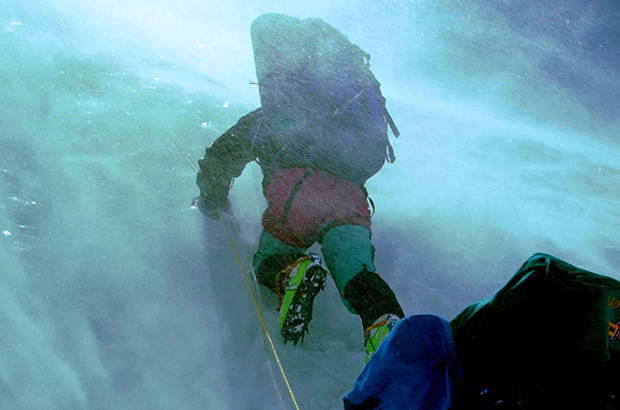
A rope that is not secured to the slope creates serious additional risks for a team of roped climbers
Ø Using an ice ax. It is difficult to imagine for what purposes an ice ax can be used on a gentle snow slope while walking up a marked path. Despite this, you often can see that climbing the South slope of Mount Elbrus, they attach the ice ax on the back of their backpack. So hanging there is does not perform any functions apart from creating the additional load.
When climbing the south slope of Mount Elbrus in standard summer conditions, the likelihood that you will need an ice ax is equal to approximately zero
I'll say more. Even when climbing Mount Elbrus in the totally different winter conditions, when progressing on the open, smooth and very dangerous "bottle" ice, the benefit of an ice ax is very doubtful. In case of fall, it will be almost impossible to do self arrest with at ice ax on a smooth and extremely dense ice surface.
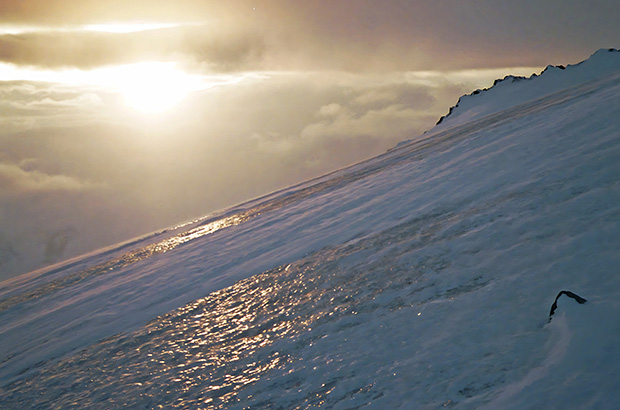
Super-dense winter bottle ice on the slope of Mount Elbrus. Don’t have these illusions - self-arrest with an ice ax in case of a fall is impossible
Ø Using of a helmet while climbing Mount Elbrus. The purpose of this part of equipment is, first of all, to protect your head from the objects falling from above. Wearing a helmet in order to protect yourself from falling headfirst - on a gentle slope with a good trail - that looks as ridiculous as if you wore a helmet to the theater, fearing that a chandelier would fall on you...
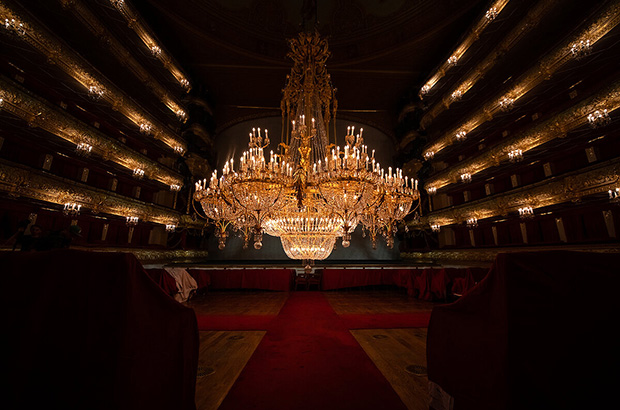
There is always a chance that a chandelier will fall on your head during your being in the theater. But no one wears a helmet
Using helmet is relevant and obligatory climbing the rock or mixed routes with a risk of rockfall. Or on the steep ice pitches when there is a possibility of falling of the fragments of ice.
Neither one nor the other danger exist if you are climbing Mount Elbrus in the summer season along the popular South or North routes. As the probability of a rockfall is close to zero (snow cover reliably holds the rocks on the slopes),. As for the fall - you can only do it on a trail because of fatigue, and even then, for sure not your upside down.
Falling from fatigue at the summit of Mount Elbrus. Not an accident, but a well-deserved break
But the helmet definitely provides extra weight and inconvenience for all the length of the climb - do not forget that the route is very long - even the slight discomfort, after 8-10 hours of continuous walking uphill, can turn into a serious problem.
---------------------------------------------------------------------------------------------------
When preparing all my expeditions to Mount Elbrus, I pay maximum attention to the technical and tactical training of the participants, explaining to them all the features and specifics of the routes. Climbing tactics are chosen depending on the route, physical fitness and level of training of the participants.
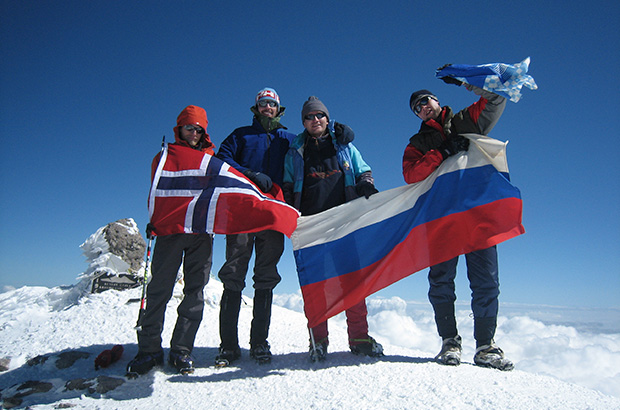
Successful climb of Mount Elbrus is not complicated, but requires reasonable preparation and competent guidance
The author of the texts and photographs Alex Trubachev
Your professional mountain guide for Mount Elbrus and other mountains in Caucasus
MCS EDIT 2024
Our Principles
AlexClimb Rule #1 - Safety First
From the very beginning of our activity, here nearly 16 years, the first Principle of work of School of mountaineering and rock-climbing of MCS AlexClimb is the Safety Priority. On the basis of this Principle all process of training is based, all programs and rounds are developed and carried out only within this main principle. We consider that at professional approach to development of programs, at personal discipline and correctly put motivation - occupations by mountaineering and rock-climbing are COMPLETELY safe. And from the return - all troubles and accidents in our sport come from nonprofessionalism, from ignorance or neglect by elementary standards of safety, from irrational motivation, from revaluation of own forces and opportunities. All these prerequisites we COMPLETELY EXCLUDE in our work - ours Rock-climbing, Ice climbing and Mountaineering are based on one Principle - the Safety Priority. In rock-climbing, mountaineering and ice climbing, the Priority of Safety of MCS AlexClimb-is your personal security and comfort irrespective of, than we are engaged - we train muscles and we work technology of the movement in the sports hall and on the rock climbing wall, we make the way through snowstorm to top or we relax on golden sand of the Caribbean beach after hot day of trainings on rocks. The Safety priority - the main credo of School of mountaineering and rock-climbing of MCS AlexClimb.
AlexClimb Rule #2 - Leave No Trace
Closely interacting with Nature, working with the active programs in mountains, woods, lakes and rivers, we perfectly understand the importance of carefull and respectfull bahavior towards the Nature, for its resources. From the very beginning of our outdoor-activity we adopted rules of Leave No Trace technique - the standard of behavior of the person accepted in all the civilized world in relation to environment and especially - to the wild nature. After all on the relation of people to the nature near which they exist, itself can draw dalekoidushchy conclusions on the relation of these people to... Where and as we didn't travel - we don't reserve any garbage, we try to reduce whenever possible our influence on environment to a minimum. We clear earlier zagryazyonny tourist parking of the left garbage, we take out and we take out to utilization places that to us other people left there. We consider that only thus, at personal individual consciousness of each citizen, each tourist, climber or autotraveller, we will be able to keep the nature surrounding us in its state, natural, suitable for life, - in it pledge of the healthy future for ourselves and our children.





